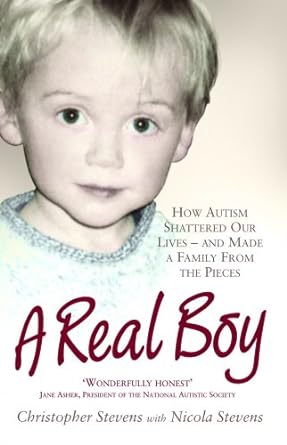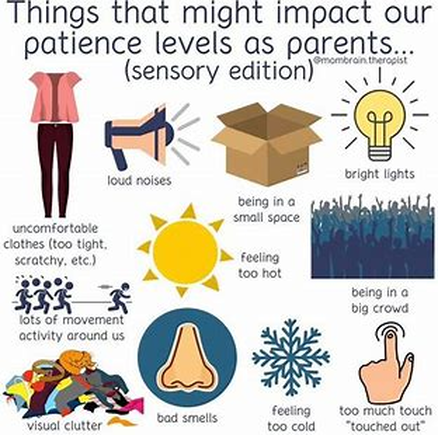What is the most concerning or destructive thing that is going on right now in your child’s world?
MORE SENSORY (Continued)
More CONCERNS about how ‘quirky’ behavior may be triggered by a ‘sensory’ moment –
David wasn’t there. Calling to him was pointless… Out the door, with my arms folded across my chest and doing that high-stepping trot which only barefoot adults on stony tarmac can achieve, I tried to guess where David would go.
…I caught sight of David: he was marching with a purpose to the grocery shop.
And then there was a shriek, so blood-chilling that Vince must have thought he’d accidentally hurt the little shoplifter…
‘He’s with me,’ I shouted, and tried to give Vince a thumbs up as I scooped David off the floor and kept my robe shut at the same time. Vince pressed the sweets into David’s hand, a free gift.
< My Thoughts > “I tried to guess where David would go.”
Unfortunately, children with autism, no matter his or her age, have no safety concerns. They live their own little world, and ‘in the moment’. They are often driven by sudden sensory needs. Therefore, parents and caregiver must be constantly vigilant, never assuming anything. Also, just because the child did or didn’t do a behavior before, doesn’t meant it will not happen today.
Chantal Sicile-Kira, The Autism Advocate reminds us that… “children on the autism spectrum are at a higher risk of being hurt, victimized or wandering off. Children with autism do not appear to have a safety 'antenna' built in, and their sensory processing does not effectively work to help them in the area of safety and crisis prevention.”
More about how ‘quirky’ behavior may be triggered by a ‘sensory’ moment –
Author Elaine Hall (2011) tells us that when my son, Neal, stopped to look at the hubcap of a car parked along the street, I stopped to look too. Kneeling down, what I see is the most beautiful thing; the sun falling on a hubcap creates a kaleidoscope of brilliant, shining shards of light. It is magical. That day I grew in compassion and understanding.
< My Thoughts > Planning for the future…
Baldwin, et al. (2014) believe there are significant challenges faced by adults with Autism and Asperger’s Disorder.
Difficulty in –
- ‘Thinking on their feet’
- Acclimating to new procedures after learning & following set ones
- Responding flexibly to unexpected situations
- Planning & juggling multiple tasks
- Communicating effectively with co-workers
- Interacting socially
- Managing sensory sensitivities in the workplace
Accordingly, there could be difficulty in coping with the rapid processing of demands of a cashier, cook, waiter or receptionist. Persons with ASD may struggle in busy or noisy environments these workers find themselves in.
On the other hand, persons with ASD may perform extremely well in jobs which require –
- visual thinking
- systematic information processing
Baldwin, et al. continues by saying that, “Persons with ASD or High Functioning Autism (HFA) may face a lack of understanding and support in employment settings.”
Jones, S. R. (2016) writes – A is for Acceptance – You may have noticed in the last half-decade or so that there is a growing trend toward speaking of Autism acceptance instead of Autism awareness.
(Acceptance because…) beneath Autism, there is more Autism – it’s Autism all the way to the core. Autistic children do not “go into remission,” we develop coping skills and we mature into Autistic adults, and we work to learn ways to communicate with those around us.
Senator, 91% What autism has taught us is that we can do many things to prepare Nat for adult life, to help him participate in the world, and yet it’s painfully clear that the world still is not ready for him. Nat’s brothers continue to buzz around him, interacting with him differently with each new phase of theirs. I still try to find a common denominator for all three.
< My Thoughts > “…help him participate in the world…”
The adult-world can be unaccommodating to adults with autism.
Finding their place in the social adult-world can be difficult for adolescents and adults Especially for those with severe ‘sensory issues’.
Staff Writer (2023). Things that help: moving as much as I want to, sitting in weird positions in my chair, using my standing desk so I can fidget more, getting extra pressure, sometimes wearing tighter clothing or an underlayer can help with giving low level proprioceptive input throughout the day. Things like yoga and stretching once away from the office can also be helpful as these give your joints a bit of extra input.
Obviously, there has been a lot of trial and error. When I was first experimenting to find out what works, I used a lot of visual reminders. To nudge me to do things or to avoid things that I wasn’t used to paying attention to. Those reminders ranged from a little picture on my whiteboard to calendar reminders at key points during the day.
PART 1. HYPO-ACTIVITY
PART 2. HYPER-ACTIVITY
Note: Sensory reactions are never ‘planned’ events, only responses to sensory insults.
References:
Baldwin, S., Costley, D., Warren, A. (2014). Employment Activities & Experiences of Adults with High-Functioning Autism & Asperger’s Disorder; Journal of Autism & Developmental Disorders;V44, p2440-2449.
Hall, E. & Kaye, E. (2011). Now I See the Moon: A Mother, a Son, a Miracle; Harper Collins Publishers, New York, N.Y.
Jones, S. R. (2016). ABCs of Autism Acceptance; eBook Edition.
Luker, S. (2024); Know Autism, Know Your Child with < My Thoughts > by Sara Luker; Retrieved online from – www.sarasautismsite.com
Senator, S. (2006). Making Peace with Autism: One Family’s Story of Struggle, Discovery & Unexpected Gifts; eBook Edition.
Staff Writer (2023). Managing workplace sensory issues.
Retrieve online from – https://employmentautism.org.uk/managing-workplace-sensory-issues/
Stevens, C. & Stevens, N. (2011). A Real Boy: How Autism Shattered our Lives & Made a Family from the Pieces; e-Book Edition.
Note: DISCLAIMER – Autism ‘intervention’, as with the phrase ‘Early Detection / Early Intervention’, may simply mean to attempt an ‘action’, or attempt to ‘change a course’ or ‘trajectory’ of the person’s autism. Any expectation for a successful ‘change’ must have the cooperation of the participant, the parent, and/or the assigned therapist. Words such as, ‘intervention’, ‘treatment’, ‘therapy’, ‘service’, or ‘program’ imply ‘cure’, or ‘long-term’ positive effect. That is NOT my intention here, and all information is presented without intent or suggestion of status or effectiveness.
End of DAY SIXTEEN. Note: Excerpts from the books – (13% indicates location in the Kindle version of the eBook, instead of page numbers).
Sharing of my website and BLOG Comments welcomed. Thank-you to those of you who have sent comments... much appreciated!
Regards,
Sara Luker



 RSS Feed
RSS Feed